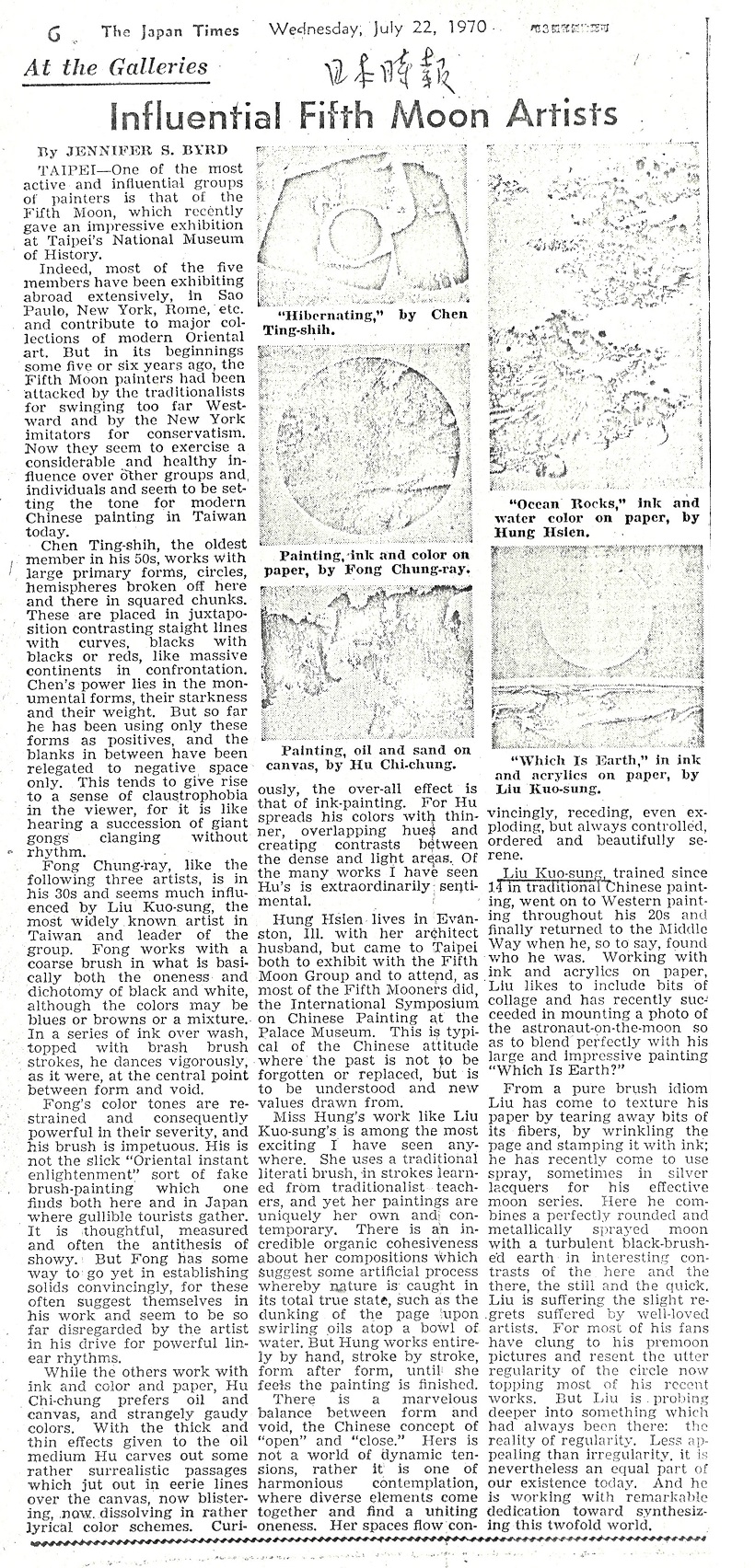Influential Fifth Moon Artists
- 期刊與書籍
- The Japan Times
- Jennifer S. Byrd
- 1970.7
TAIPEI – One of the most active and influential groups of painters is that of the Fifth Moon, which recently gave an impressive exhibition at Taipei’s National Museum of History.
Indeed, most of the five members have been exhibiting abroad extensively, in Sao Paulo, New York, Rome, etc. and contribute to major collections of modern Oriental art. But in its beginnings some five or six years ago, the Fifth Moon painters had been attacked by the traditionalists for swinging too far Westward and by the New York imitators for conservatism. Now they seem to exercise a considerable and healthy influence over other groups and individuals and seem to be setting the tone for modern Chinese painting in Taiwan today.
Chen Ting-shih, the oldest member in his 50s, works with large primary forms, circles, hemispheres broken off here and there in squared chunks. These are placed in juxtaposition contrasting straight lines with curves, blacks with blacks or reds, like massive continents in confrontation. Chen’s power lies in the monumental forms, their starkness and their weight. But so far he has been using only these forms as positives, and the blanks in between have been relegated to negative space only. This tends to give rise to a sense of claustrophobia in the viewer, for it is like hearing a succession of giant gongs clanging without rhythm.
Fong Chung-ray, like the following three artists, is in his 30s and seems much influenced by Liu Kuo-sung, the most widely known artist in Taiwan and leader of the group. Fong works with a coarse brush in what is basically both the oneness and dichotomy of black and white, although the colors may be blues or browns or a mixture. In a series of ink over wash, topped with brash brush strokes, he dances vigorously, as it were, at the central point between form and void.
Fong’s color tones are restrained and consequently powerful in their severity, and his brush is impetuous. His is not the slick “Oriental instant enlightenment” sort of fake brush-painting which one finds both here and in Japan where gullible tourists gather. It is thoughtful, measured and often the antithesis of showy. But Fong has some way to go yet in establishing solids convincingly, for these often suggest themselves in his work and seem to be so far disregarded by the artist in his drive for powerful linear rhythms.
While the others work with ink and color and paper, Hu Chi-chung prefers oil and canvas, and strangely gaudy colors. With the thick and thin effects given to the oil medium Hu carves out some rather surrealistic passages which jut out in eerie lines over the canvas, now blistering, now dissolving in rather lyrical color schemes. Curiously, the overall effect is that of ink-painting. For Hu spreads his colors with thinner, overlapping hues and creating contrasts between the dense and light areas. Of the many works I have seen, Hu’s is extraordinarily sentimental.
Hung Hsien lives in Evanston, Ill. With her architect husband, but came to Taipei both to exhibit with the Fifth Moon Group and to attend, as most of the Fifth Mooners did, the International Symposium on Chinese Painting at the Palace Museum. This is typical of the Chinese attitude where the past is not to be forgotten or replaced, but is to be understood and new values drawn from.
Miss Hung’s work like Liu Kuo-sung’s is among the most exciting I have seen anywhere. She uses a traditional literati brush, in strokes learned from traditionalist teachers, and yet her paintings are uniquely her own and contemporary. There is an incredible organic cohesiveness about her compositions which suggest some artificial process whereby nature is caught in its total true state, such as the dunking of the page upon swirling oils atop a bowl of water. But Hung works entirely by hand, stroke by stroke, form after form, until she feels the painting is finished.
There is a marvelous balance between form and void, the Chinese concept of “open” and “close.” Hers is not a world of dynamic tensions, rather it is one of harmonious contemplation, where diverse elements come together and find a uniting oneness. Her spaces flow convincingly, receding, even exploding, but always controlled, ordered and beautifully serene.
Liu Kuo-sung, trained since 14 in traditional Chinese painting, went on to Western painting throughout his 20s and finally returned to the Middle Way when he, so to say, found who he was. Working with ink and acrylics on paper, Liu likes to include bits of collage and has recently succeeded in mounting a photo of the astronaut-on-the-moon so as to blend perfectly with his large and impressive painting “Which Is Earth?”
From a pure brush idiom Liu has come to texture his paper by tearing away bits of its fibers, by wrinkling the page and stamping it with ink; he has recently come to use spray, sometimes in silver lacquers for his effective moon series. Here he combines a perfectly rounded and metallically sprayed moon with a turbulent black-brushed earth in interesting contrasts of the here and the there, the still and the quick. Liu is suffering the slight regrets suffered by well-loved artists. For most of his fans have clung to his premoon pictures and resent the utter regularity of the circle now topping most of his recent works. But Liu is probing deeper into something which had always been there: the reality of regularity. Less appealing than irregularity, it is nevertheless an equal part of our existence today. And he is working with remarkable dedication toward synthesizing this twofold world.
